📊Group | 📌 |
|---|
📊Size | Giant📌 |
|---|
📊Utilization | Watch and security dog |
|---|
✨Appearance | Head, in general outline, giving a square appearance when viewed from any point. Breadth desired and in ratio to length of whole head and face as 2 : 3. Body broad, deep, long, powerfully built, on legs wide apart and set. Muscles sharply defined. Size is desirable, but only if combined with quality and if absolute soundness is maintained. Height and substance important if both points are proportionately combined. Large, powerful, well-knit frame. |
|---|
🖍️Nicknames | Old English Mastiff English Mastiff |
|---|
🌐Country of origin | Great britain |
|---|
⌛Lifespan, years | 6 - 10 |
|---|
📏Height | 70 cm - 91 cm |
|---|
⚖Weight | 60 kg - 100 kg |
|---|
🌡Temperament | A combination of grandeur and courage. Calm, affectionate to owners, but capable of guarding. Usually indifferent with strangers; timidity is unacceptable. |
|---|
📜History | The Mastiff, perhaps not in exactly the form as we know it today, has been with us for many hundreds of years, and played its part in history since well before the Battle of Agincourt, in the early fifteenth century. Even then the Mastiff was known for his courage and guarding instincts. It is recorded that when the Romans invaded Britain they found a mastiff type dog already here, and were so impressed that they took some back to fight in the arenas of Rome. When the Normans came to Britain the mastiff type was so common that the French word dogue found its way into the English language. The breed almost became extinct in Britain after the Second World War. Stock was then imported, and since that time the numerical strength and quality of the breed have taken an upsurge. Combining grandeur with good nature, he is an extremely large dog in both height and girth, broad and deep in body, full of substance, with large strong bones. |
|---|

